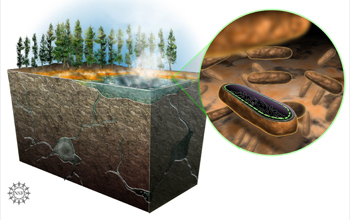Multimedia Gallery
Unique Bacterium in Yellowstone Springs
Artist's representation of a unique species of chlorophyll-producing bacterium that was discovered in the hot springs of Yellowstone National Park. The green shapes in the cell, called chlorosomes, house the machinery to convert sunlight into energy.
This image accompanied NSF press release, "Innovative Research Technique Reveals Another Natural Wonder in Yellowstone Park: A Unique, Photosynthesizing Life-For."
Credit: Nicolle Rager Fuller, National Science Foundation
Images and other media in the National Science Foundation Multimedia Gallery are available for use in print and electronic material by NSF employees, members of the media, university staff, teachers and the general public. All media in the gallery are intended for personal, educational and nonprofit/non-commercial use only.
Images credited to the National Science Foundation, a federal agency, are in the public domain. The images were created by employees of the United States Government as part of their official duties or prepared by contractors as "works for hire" for NSF. You may freely use NSF-credited images and, at your discretion, credit NSF with a "Courtesy: National Science Foundation" notation.
Additional information about general usage can be found in Conditions.
Also Available:
Download the high-resolution JPG version of the image. (263 KB)
Use your mouse to right-click (Mac users may need to Ctrl-click) the link above and choose the option that will save the file or target to your computer.



